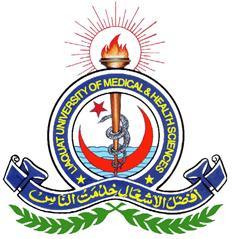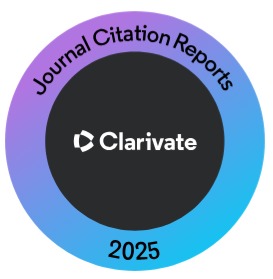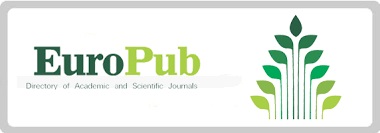Comparison of Isokinetic Strength Parameters of Quadriceps in Athletes and Non-Athletes
Keywords:
Athletes and non-athletes, Correlation, Isokinetic, Peak TorqueAbstract
OBJECTIVE: To compare the quadriceps isokinetic strength parameters of athletes and non-athletes.
METHODOLOGY: The cross-sectional study was conducted from July to December 2019 at the Pakistan Sports Board, Islamabad. The sample size was 81, selected through a non-probability convenience sampling technique and calculated by the Rao Soft tool. The 41 participants were in the athletes' group, and 40 were in the non-athletes' group. Individuals with a history of sprain, strain, or fracture in the lower limbs within the last six months were excluded. The self-structured questionnaire includes demographic data, waist-to-hip ratio, thigh circumference, peak torque values and agility t-test score. The isokinetic strength of the right lower limb (RLL) was measured via Biodex system Pro 3. Data was analyzed through SPSS 22, and an independent t-test was applied for analysis between groups. Pearson test was used for the correlation coefficient.
RESULTS: Athletes had significantly higher quadriceps muscle strength than non-athletes (p<0.001), indicating the positive impact of regular sports participation and physical training. Quadriceps peak torque positively correlated with thigh circumference (r=0.60, p<0.001), consistent with previous studies. Surprisingly, athletes exhibited a weak to moderate negative correlation between quadriceps peak torque and agility (r=-0.35, p<0.05), suggesting a potential trade-off between muscle mass and agility performance. Increased muscle bulk may compromise speed and flexibility.
CONCLUSION: Athletes demonstrated superior quadriceps muscle strength, emphasizing the positive influence of sports involvement and physical training; thigh circumference positively correlated with Quadriceps peak torque, and Agility negatively correlated with quadriceps peak torque.
References
Wirth K, Hartmann H, Mickel C, Szilvas E, Keiner M, Sander A. Core stability in athletes: a critical analysis of current guidelines. Sports Med. 2017 Mar; 47(3): 401-14. doi: 10.1007/s40279-016-0597-7.
Aquatic Exercise Association. Aquatic fitness professional manual. Human Kinetics; 2017 Oct 17.
Venturini E, Giallauria F. Factors Influencing Running Performance During a Marathon: Breaking the 2-h Barrier. Front Cardiovasc Med. 2022 Mar 2; 9: 856875. doi: 10.3389/fcvm.2022.856875.
Konrad A, Mo?nik R, Nakamura M. Effects of tissue flossing on the healthy and impaired musculoskeletal system: A scoping review. Front Physiol. 2021 May 21; 12: 666129. Doi: 10.3389/fphys.2021.666129.
Cope E, Cushion CJ, Harvey S, Partington M. Re-visiting systematic observation: A pedagogical tool to support coach learning and development. Front Sports Act Living. 2022. Aug; 4: 962690. Doi: 10.3389/fspor.2022.962690.
Boraczy?ski M, Boraczy?ski T, Podstawski R, Wójcik Z, Gronek P. Relationships between measures of functional and isometric lower body strength, aerobic capacity, anaerobic power, sprint and countermovement jump performance in professional soccer players. J Hum Kinet. 2020 Oct 31; 75: 161-75. doi: 10.2478/hukin-2020-0045.
Beato M, Drust B, Iacono AD. Implementing high-speed running and sprinting training in professional soccer. Int J Sports Med. 2021 Apr; 42(4): 295-9. doi: 10.1055/a-1302-7968. Epub 2020 Dec 8.
Valenzuela PL, Rivas F, Sánchez-Martínez G. Effects of COVID-19 lockdown and a subsequent retraining period on elite athletes' workload, performance, and autonomic responses: a case series. Int J Sports Physiol Perform. 2021 Nov 1; 16(11): 1707-11. doi: 10.1123/ijspp.2020-0735. Epub 2021 Apr 19.
D'Emanuele S, Maffiuletti NA, Tarperi C, Rainoldi A, Schena F, Boccia G. Rate of force development as an indicator of neuromuscular fatigue: a scoping review. Front Hum Neurosci. 2021 Jul 9; 15: 701916. doi: 10.3389/ fnhum.2021.701916.
Calder AR, Duthie GM, Johnston RD, Engel HD. Physical demands of female collegiate lacrosse competition: whole-match and peak periods analysis. Sport Sci Health. 2021 Mar; 17(4): 103-9. Doi: 10.1007/s11332-020-00659-x.
Andrade MD, De Lira CA, Koffes FD, Mascarin NC, Benedito-Silva AA, Da Silva AC. Isokinetic hamstrings-to-quadriceps peak torque ratio: The influence of sport modality, gender, and angular velocity. J Sports Sci. 2012; 30(6): 547-53. doi: 10.1080/02640414.2011.644249.
Skopal L, Netto K, Aisbett B, Takla A, Castricum T. The effect of a rhythmic gymnastics-based power-flexibility program on the lower limb flexibility and power of contemporary dancers. Int J Sports Phys Ther. 2020 May; 15(3): 343-64.
Delextrat A, Bateman J, Ross C, Harman J, Davis L, Vanrenterghem J et al. Changes in torque-angle profiles of the hamstrings and hamstrings-to-quadriceps ratio after two hamstring strengthening exercise interventions in female hockey players. J Strength Cond Res. 2020 Feb; 34(2): 396-405. doi: 10.1519/JSC.0000000000003309.
?liwowski R, Marynowicz J, Grygorowicz M, Wieczorek A, Jadczak ?. Are There Differences in Concentric Isokinetic Strength Performance Profiles between International and Non-International Elite Soccer Players? Int J Environ Res Public Health. 2020 Dec 23; 18(1): 35. doi: 10.3390/ijerph18010035.
Fessi MS, Makni E, Jemni M, Elloumi M, Chamari K, Nabli MA et al. Reliability and criterion-related validity of a new repeated agility test. Biol Sport. 2016; 33(2): 159-164. Doi: 10.5604/20831862.1198635.
Malm C, Jakobsson J, Isaksson A. Physical activity and sports-real health benefits: a review with insight into the public health of Sweden. Sports(Sweden). 2019 May; 7(5): 127. Doi: 10.3390/sports7050127.
Maestroni L, Read P, Bishop C, Papadopoulos K, Suchomel TJ, Comfort P et al. The benefits of strength training on musculoskeletal system health: practical applications for interdisciplinary care. Sports Med. 2020 Aug; 50(8): 1431-1450. doi: 10.1007/s40279-020-01309-5.
Lin S, Liu J, Liu X, Zhao X. Muscle-like fatigue-resistant hydrogels by mechanical training. Proc Natl Acad Sci USA. 2019 May 21; 116(21): 10244-10249. doi: 10.1073/pnas.1903019116. Epub 2019 May 8.
Kozinc Ž, Markovi? G, Hadži? V, Šarabon N. Relationship between force-velocity-power profiles and inter-limb asymmetries obtained during unilateral vertical jumping and singe-joint isokinetic tasks. J Sports Sci. 2021 Feb 1; 39(3): 248-58. doi: 10.1080/02640414.2020.1816271. Epub 2020 Sep 8.
Avramescu ET, Neamtu MC, Rusu L, Mangra G. New methods of data aquisition and walking analysis in multiple sclerosis after functional electrical stimulation. Ovidius University Annals, Series Physical Education & Sport/Science, Movement & Health. 2010 Mar 1; 10(1): S73+.
Grgic J. Effects of caffeine on resistance exercise: a review of recent research. Sports Med. 2021 Nov; 51: 2281-98. doi: 10.1007/s40279-021-01521-x. Epub 2021 Jul 22.
Delleli S, Ouergui I, Messaoudi H, Trabelsi K, Ammar A, Glenn JM et al. Acute effects of caffeine supplementation on physical performance, physiological responses, perceived exertion, and technical-tactical skills in combat sports: A systematic review and meta-analysis. Nutrients. 2022 Jul 21; 14(14): 2996. doi: 10.3390/nu14142996.
Suchomel TJ, Nimphius S, Bellon CR, Stone MH. The importance of muscular strength: Training considerations. Sports Med. 2018 Apr; 48(4): 765-85. doi: 10.1007/s40279-018-0862-z.
Oliver JL, Ayala F, Croix MB, Lloyd RS, Myer GD, Read PJ. Using machine learning to improve our understanding of injury risk and prediction in elite male youth football players. J Sci Med Sport. 2020 Nov 1; 23(11): 1044-8. doi: 10.1016/j.jsams.2020.04.021. Epub 2020 May 18.
Harper DJ, McBurnie AJ, Santos TD, Eriksrud O, Evans M, Cohen DD et al. Biomechanical and neuromuscular performance requirements of horizontal deceleration: A review with implications for random intermittent multi-directional sports. Sports Med. 2022; 52(10): 2321-54. Doi: 10.1007/s40279-022-01693-0.
Downloads
Published
How to Cite
Issue
Section
License
Copyright (c) 2023 Journal of Liaquat University of Medical & Health Sciences

This work is licensed under a Creative Commons Attribution-NonCommercial-ShareAlike 4.0 International License.
Submission of a manuscript to the journal implies that all authors have read and agreed to the content of the undertaking form or the Terms and Conditions.
When an article is accepted for publication, the author(s) retain the copyright and are required to grant the publisher the right of first publication and other non-exclusive publishing rights to JLUMHS.
Articles published in the Journal of Liaquat University of Medical & health sciences are open access articles under a Creative Commons Attribution-Noncommercial - Share Alike 4.0 License. This license permits use, distribution and reproduction in any medium; provided the original work is properly cited and initial publication in this journal. This is in accordance with the BOAI definition of open access. In addition to that users are allowed to remix, tweak and build upon the work non-commercially as long as appropriate credit is given and the new creations are licensed under the identical terms. Or, in certain cases it can be stated that all articles and content there in are published under creative commons license unless stated otherwise.























